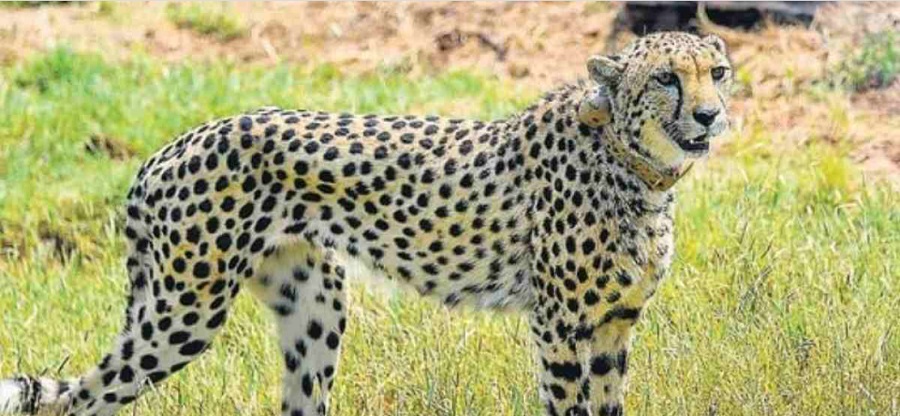Why the scheme is in the news?
A team of experts from South Africa and India visited Kuno National Park to review the status of Project Cheetah. They found that 20 cheetahs were successfully translocated to KNP in September 2022 and February 2023. The project aims to restore the species to its historical range in India, benefit global cheetah conservation efforts, and enhance ecosystem health. The team submitted a report on the project’s current status and future directions.
Buy Prime Test Series for all Banking, SSC, Insurance & other exams
A Chronological Overview of Cheetah Reintroduction in India
- Cheetah’s Background: The cheetah, known scientifically as Acinonyx Jubatus, holds the title for the fastest land animal. Unfortunately, overhunting and habitat loss led to their complete extinction in India, making them the only large carnivore to face this fate.
- Name Origins: The name “Cheetah” has Sanskrit origins, meaning “variegated,” “adorned,” or “painted.”Historical Mentions: Cheetahs were recorded in classical Greek texts by Strabo around 200 BCE. During the Mughal Period, they were heavily used for hunting, and Emperor Akbar owned a menagerie of 1,000 cheetahs. Various states in Central India, particularly Gwalior, had cheetahs for a long time.1947: India’s last spotted cheetah died in the Sal forests of Chhattisgarh’s Koriya district in 1948, leading to the animal’s official extinction in India in 1952. The country’s last three surviving cheetahs were shot by Maharaja Ramanuj Pratap Singh, the ruler of a small princely state in Chhattisgarh.
- First Reintroduction Plan: The first concrete efforts to reintroduce the cheetah began in the 1970s during talks with Iran’s Shah Muhammad Reza Pahlavi. The plan involved swapping India’s Asiatic lions for Iran’s Asiatic cheetahs.
- 2009: In 2009, a second attempt was made to acquire Iranian cheetahs, but it was unsuccessful as Iran did not permit the cloning or export of its cheetahs.
- 2012: The reintroduction project was halted in 2012 when the Supreme Court ordered a stay on it.
- 2020: In 2020, South African experts surveyed four potential reintroduction sites, namely Kuno-Palpur, Nauradehi Wildlife Sanctuary, Gandhi Sagar Wildlife Sanctuary, and Madhav National Park.
About the recent translocation programme
- Project Cheetah: India is undertaking the world’s first intercontinental large wild carnivore translocation project to reintroduce cheetahs to the country.
- Coexistence approach: Unlike previous cheetah reintroduction efforts, India’s approach is unique in that it aims to reintroduce the cheetah in an unfenced protected area using a coexistence approach.
- Significance of Coexistence approach: This approach is favored by social scientists, as fencing has been successful in eliminating cheetahs’ tendency to range over wide distances in other countries, limiting population growth. Additionally, Kuno NP’s core conservation area is largely free of human-made threats.
- Challenges associated with Coexistence approach: Reintroduction to Kuno NP will be challenging, as the park is unfenced and there have been no successful reintroductions into unfenced systems. Anthropogenic threats like snaring for bush meat and retaliatory killings due to livestock depredation pose risks to the cheetahs.
- Fortress conservation: While cheetahs have been reintroduced in fenced protected areas in various African countries, India’s coexistence approach presents a new frontier for conservation efforts.
Significance of Cheetah reintroduction
- India’s historical cheetah habitat was widespread, ranging from Jammu to Tamil Nadu, and encompassed various habitats such as dry forests, grasslands, and scrub forests.
- Experts believe that as long as there is enough food and protection, cheetahs can regenerate on their own. The Kuno-Palpur sanctuary has already prepared a “prey base” that can sustain the population.
- The reintroduction of cheetahs will aid in the restoration of open forest and grassland ecosystems in India. As a flagship grassland species, the conservation of cheetahs also helps in preserving other species in the predator food chain.
- The conservation of cheetahs will help in the preservation of biodiversity and enhance ecosystem services such as water security, carbon sequestration, and soil moisture conservation, which will benefit society at large.
- The reintroduction of cheetahs will also create enhanced livelihood opportunities for the local community through eco-development and ecotourism activities.
Challenges:
- Coexistence with tigers and leopards:
In Kuno, there may be competition between the big cats, leading to intra-guild competition.
The more aggressive predators such as tigers and leopards may outcompete the cheetahs and force them to the outskirts of the park where they may come into conflict with humans. - Locational Challenges of Kuno-Palpur National Park: Different vegetation type: The protected area of Kuno-Palpur National Park is largely dry deciduous forest, which is different from the savannahs in Africa where cheetahs typically live. It is unclear how well the African cheetahs will adapt to this habitat.
- Specific prey base: Indian cheetahs mainly hunted blackbucks and chinkaras, and occasionally chital and nilgai. However, some of these prey species are believed to have disappeared from Kuno, which could pose a challenge to the cheetahs’ survival.
- Asiatic lion project: For the Asiatic lion project, 24 villages were relocated and rehabilitated from Kuno. However, the reintroduction of cheetahs may delay this project.
Way Forward
- Livestock protection: A functional compensation scheme should be put in place to address potential livestock losses due to cheetah reintroduction in India.
- Monitoring: All cheetahs have been fitted with radio collars and will be monitored via satellite. A dedicated team will also monitor each cheetah’s location for 24 hours.
- Prey base augmentation: To increase the prey base inside the 500-hectare enclosure, the Kuno National Park has introduced 238 spotted deer from Pench and Narsinghgarh Wildlife Sanctuaries and plans to bring in around 300 more.
- Gradual coexistence: According to the Centre’s action plan, the cheetah and leopard populations will be able to coexist over time.
You may also read this:
- Project-SMART for Station Area Development
- Kisan Credit Card Scheme: Benefits, Eligibility, and Features
Find More News Related to Schemes & Committees








 States and Capitals - How Many States in...
States and Capitals - How Many States in...
 Which is the Most Mango Producing Countr...
Which is the Most Mango Producing Countr...
 Richest Man in the World by May 2025, Kn...
Richest Man in the World by May 2025, Kn...

